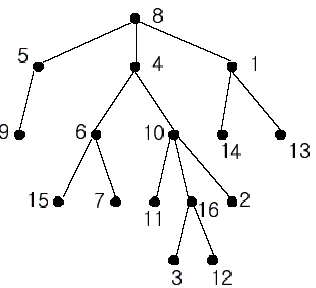【POJ】1330 Nearest Common Ancestors ——最近公共祖先(LCA)
Nearest Common Ancestors
| Time Limit: 1000MS | Memory Limit: 10000K | |
| Total Submissions: 18136 | Accepted: 9608 |
Description

In the figure, each node is labeled with an integer from {1,
2,...,16}. Node 8 is the root of the tree. Node x is an ancestor of node
y if node x is in the path between the root and node y. For example,
node 4 is an ancestor of node 16. Node 10 is also an ancestor of node
16. As a matter of fact, nodes 8, 4, 10, and 16 are the ancestors of
node 16. Remember that a node is an ancestor of itself. Nodes 8, 4, 6,
and 7 are the ancestors of node 7. A node x is called a common ancestor
of two different nodes y and z if node x is an ancestor of node y and an
ancestor of node z. Thus, nodes 8 and 4 are the common ancestors of
nodes 16 and 7. A node x is called the nearest common ancestor of nodes y
and z if x is a common ancestor of y and z and nearest to y and z among
their common ancestors. Hence, the nearest common ancestor of nodes 16
and 7 is node 4. Node 4 is nearer to nodes 16 and 7 than node 8 is.
For other examples, the nearest common ancestor of nodes 2 and 3 is
node 10, the nearest common ancestor of nodes 6 and 13 is node 8, and
the nearest common ancestor of nodes 4 and 12 is node 4. In the last
example, if y is an ancestor of z, then the nearest common ancestor of y
and z is y.
Write a program that finds the nearest common ancestor of two distinct nodes in a tree.
Input
input consists of T test cases. The number of test cases (T) is given in
the first line of the input file. Each test case starts with a line
containing an integer N , the number of nodes in a tree,
2<=N<=10,000. The nodes are labeled with integers 1, 2,..., N.
Each of the next N -1 lines contains a pair of integers that represent
an edge --the first integer is the parent node of the second integer.
Note that a tree with N nodes has exactly N - 1 edges. The last line of
each test case contains two distinct integers whose nearest common
ancestor is to be computed.
Output
Sample Input
2
16
1 14
8 5
10 16
5 9
4 6
8 4
4 10
1 13
6 15
10 11
6 7
10 2
16 3
8 1
16 12
16 7
5
2 3
3 4
3 1
1 5
3 5
Sample Output
4
3
Source
#include <cstdio>
#include <cstring>
#include <vector>
using namespace std; const int LEN = ; vector<int> vec[LEN];
int uset[LEN];
bool vis[LEN];
bool root[LEN]; void init(int n)
{
for(int i = ; i <= n; i++)
vec[i].clear();
} void makeset(int n)
{
uset[n] = n;
} int findset(int x)
{
return x == uset[x] ? x : uset[x] = findset(uset[x]);
} void unionset(int x, int y) //并查集操作
{
x = findset(x);
y = findset(y);
if (x == y)
return;
uset[y] = x;
} void LCA(int u, int q1, int q2)
{
int v;
makeset(u);
for(int i = ; i < vec[u].size(); i++){
v = vec[u][i];
LCA(v, q1, q2);
unionset(u, v); //后续遍历并合并集合
}
vis[u] = true;
if (u == q1 && vis[q2] == true){ //如果访问到询问点,判断另外一个点是否被访问过,如果访问过则该点为最近公共祖先
printf("%d\n", findset(q2));
return;
}
else if (u == q2 && vis[q1] == true){
printf("%d\n", findset(q1));
return;
} } int main()
{
int T, n, a, b, q1, q2;
scanf("%d", &T);
while(T--){
memset(uset, , sizeof(uset));
memset(vis, , sizeof(vis));
memset(root, , sizeof(root));
scanf("%d", &n);
init(n);
for(int i = ; i < n - ; i++){
scanf("%d %d", &a, &b);
vec[a].push_back(b);
root[b] = true; //标注非根节点
}
scanf("%d %d", &q1, &q2);
for(int i = ; i <= n; i++)
if (root[i] != true){ //从根节点开始遍历
LCA(i, q1, q2);
break;
}
}
return ;
}
【POJ】1330 Nearest Common Ancestors ——最近公共祖先(LCA)的更多相关文章
- POJ 1330 Nearest Common Ancestors (最近公共祖先LCA + 详解博客)
LCA问题的tarjan解法模板 LCA问题 详细 1.二叉搜索树上找两个节点LCA public int query(Node t, Node u, Node v) { int left = u.v ...
- POJ - 1330 Nearest Common Ancestors 最近公共祖先+链式前向星 模板题
A rooted tree is a well-known data structure in computer science and engineering. An example is show ...
- POJ 1330 Nearest Common Ancestors 倍增算法的LCA
POJ 1330 Nearest Common Ancestors 题意:最近公共祖先的裸题 思路:LCA和ST我们已经很熟悉了,但是这里的f[i][j]却有相似却又不同的含义.f[i][j]表示i节 ...
- poj 1330 Nearest Common Ancestors 求最近祖先节点
Nearest Common Ancestors Time Limit: 1000MS Memory Limit: 10000K Total Submissions: 37386 Accept ...
- POJ 1330 Nearest Common Ancestors(Targin求LCA)
传送门 Nearest Common Ancestors Time Limit: 1000MS Memory Limit: 10000K Total Submissions: 26612 Ac ...
- POJ 1330 Nearest Common Ancestors (模板题)【LCA】
<题目链接> 题目大意: 给出一棵树,问任意两个点的最近公共祖先的编号. 解题分析:LCA模板题,下面用的是树上倍增求解. #include <iostream> #inclu ...
- POJ 1330 Nearest Common Ancestors / UVALive 2525 Nearest Common Ancestors (最近公共祖先LCA)
POJ 1330 Nearest Common Ancestors / UVALive 2525 Nearest Common Ancestors (最近公共祖先LCA) Description A ...
- POJ - 1330 Nearest Common Ancestors(基础LCA)
POJ - 1330 Nearest Common Ancestors Time Limit: 1000MS Memory Limit: 10000KB 64bit IO Format: %l ...
- POJ.1330 Nearest Common Ancestors (LCA 倍增)
POJ.1330 Nearest Common Ancestors (LCA 倍增) 题意分析 给出一棵树,树上有n个点(n-1)条边,n-1个父子的边的关系a-b.接下来给出xy,求出xy的lca节 ...
随机推荐
- opencv菜鸟学习之旅cvNorm
Norm 计算数组的绝对范数, 绝对差分范数或者相对差分范数 double cvNorm( const CvArr* arr1, const CvArr* arr2=NULL, int norm_ty ...
- ui原则
http://www.niushe.com/news/show-3683.html 设计师Joshua Porter发表了一篇文章——<Principles of User Interface ...
- Java面试题之九
四十六.Math.round(11.5)等於多少? Math.round(-11.5)等於多少? 对于这个题,只要弄清楚Math提供的三个与取整相关的方法就OK了. 1.ceil,英文含义是天花板,该 ...
- Bag of Words(BOW)模型
原文来自:http://www.yuanyong.org/blog/cv/bow-mode 重复造轮子并不是完全没有意义的. 这几天忙里偷闲看了一些关于BOW模型的知识,虽然自己做图像检索到目前为止并 ...
- hdu 5562 Clarke and food(贪心)
Problem Description Clarke is a patient with multiple personality disorder. One day, Clarke turned i ...
- 第三章:挖掘SimpleSection.o
1.查看.o目标文件用objdump 命令, 参数“-h"就是把ELF文件的各个段的基本信息打印出来.也可以使用-X打印更多的信息. 段的属性,Size是段的长度,FIle off 是段开始 ...
- 源码推荐(7.17):不规则按钮类似于遥控器按钮,一个可以最大程度简化PageView与TabView切换的第三方框架
不规则按钮,类似于遥控器按钮,可以单独控制按钮的上下左右(作者:masa_chu) 不规则按钮,类似于遥控器按钮,可以单独控制按钮的上下左右 测试环境:Xcode 6.2,iOS 6.0以上 Lazy ...
- 依赖注入及AOP简述(五)——依赖注入的方式 .
二.依赖注入的应用模式 前面我们了解了依赖注入的基本概念,也对一些依赖注入框架进行了简单的介绍,这一章我们主要来讨论作为开发者如何利用依赖注入框架来实现依赖注入的设计思想. 1. 依赖注入的方 ...
- windows+Ubuntu双系统 windows引导修复
我的博客:http://blog.csdn.net/muyang_ren 装完windows+Ubuntu麒麟双系统后,发现引导是Ubuntu的. Ubuntu的引导是GRUP windows的引导是 ...
- 从头开始-04.C语言中流程控制
分支结构: if语句:当条表达式满足的时候就执行if后面大括号中语句 三种格式: if,if else , if else if else 特点:1.只有一个代码块会被执行 2.若有else那么必有一 ...
